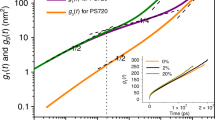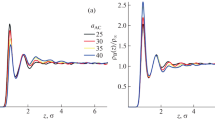Abstract
A polystyrene-b-poly-4-vinypyridine (PS-b-P4VP) diblock copolymer is modified with a gold precursor to obtain an organic–inorganic (hybrid) block copolymer in bulk with gold nanoparticles selectively incorporated in the P4VP block. In the linear viscoelastic regime, temperature sweep tests over a series of these hybrid block copolymer systems revealed consistent shifts (ΔT) in the glass transition temperatures (both T \(_{\rm g\text{-}PS}\) and T \(_{\rm g\text{-}P4VP}\)) of the hybrid materials in comparison to the pristine polymers. Studying different volume fractions of the pyridine block, a level-off point was found for block copolymers with f P4VP > 0.26, where the shifts in T \(_{\rm g\text{-}P4VP}\) consistently increased up to ΔT = 25°C. By artificially increasing the volume fraction of the pyridine block, the nanoparticles reduce the transition regime determined in master curves. At higher volume fractions of the pyridine block, crossover frequencies were not detected after the entanglement regime, indicating that the material does not relax from topological constraints (entanglements and nanoparticles) into the terminal regime. Above a specific volume fraction of nanoparticles (Φ P = 0.05), the flow behaviour of the hybrid materials becomes increasingly elastic, exhibiting wall-slip from the geometry at lower strain values in comparison to the pristine material. In the non-linear viscoelastic regime, Fourier-transformed rheology was used to analyse the raw signals from strain sweep experiments. It was clearly demonstrated the nanoparticle effect by following the second and third harmonic (I 2/1, I 3/1) of the stress response. Comparing the behaviour of the third and second harmonics provided an unambiguous fingerprint for the effect of the nanoparticles.











Similar content being viewed by others
References
Alivisatos AP (1996) Semiconductor clusters, nanocrystals, and quantum dots. Science 271:933–937
Chan YNC, Craig GSW, Schrock RR, Cohen RE (1992) Synthesis of palladium and platinum nanoclusters within microphase-separated diblock copolymers. Chem Mater 4:885–894
Filipe S, Vittorias I, Wilhelm M (2008) Experimental correlation between mechanical non-linearity in laos flow and capillary flow instabilities for linear and branched commercial polyethylenes. Macromol Mater Eng 293:57–65
Gates BD, Xu QB, Stewart M, Ryan D, Willson CG, Whitesides GM (2005) New approaches to nanofabrication: molding, printing, and other techniques. Chem Rev 105:1171–1196
Gedde U (1995) Polymer physics. Chapman and Hall, London
Grubbs RB (2005) Hybrid metal-polymer composites from functional block copolymers. J Polym Sci Part A: Polym Chem 43:4323–4336
Hamley IW (1998) The physics of block copolymers. Oxford University Press, Oxford
Hassan E, Miroslav G, Mosto B (2009) Structure build-up at rest in polymer nanocomposites: flow reversal experiments. J Polym Sci Part B: Polym Phys 47:1728–1741
Hiemenz P, Lodge T (2007) Polymer chemistry, 2nd edn. CRC, Boca Raton
Jain A, Wiesner U (2004) Silica-type mesostructures from block copolymer phases: formation mechanism and generalization to the dense nanoparticle regime. Macromolecules 37:5665–5670
Joly S, Kane R, Radzilowski L, Wang T, Wu A, Cohen RE, Thomas EL, Rubner MF (2000) Multilayer nanoreactors for metallic and semiconducting particles. Langmuir 16:1354–1359
Kannan RM, Kornfield JA (1994) Evolution of microstructure and viscoelasticity during flow-alignment of a lamellar diblock copolymer. Macromolecules 27:1177–1186
Keller A, Pedemont E, Willmout FM (1970) Macro lattice from segregated amorphous phases of a 3 block copolymer. Kolloid Z Z Polym 238:385
Kelsall R, Hamley I, Geoghegan M (2005) Nanoscale science and technology, 1st edn. Wiley, West Sussex
Kunz MS, Shull KR, Kellock AJ (1993) Colloidal gold dispersions in polymeric matrices. J Colloid Interface Sci 156:240–249
Langela M, Wiesner U, Spiess HW, Wilhelm M (2002) Microphase reorientation in block copolymer melts as detected via ft rheology and 2d saxs. Macromolecules 35:3198–3204
Larson RG (1999) The structure and rheology of complex fluids. Topics in chemical engineering. Oxford University Press, New York
Leonov AI (1984) A linear-model of the stick-slip phenomena in polymer flow in rheometers. Rheol Acta 23:591–600
Malenfant PRL, Wan JL, Taylor ST, Manoharan M (2007) Self-assembly of an organic-inorganic block copolymer for nano-ordered ceramics. Nat Nanotechnol 2:43–46
Manners I (2001) Materials science—putting metals into polymers. Science 294:1664–1666
Matsen MW, Bates FS (1996) Unifying weak- and strong-segregation block copolymer theories. Macromolecules 29:1091–1098
Mendoza C, Pietsch T, Fahmi AW, Gindy N (2008) Fabrication of 3d-periodic ordered metallic nanoparticles in a block copolymer bulk matrix via oscillating shear flow. Adv Mater 20:1179–1184
Mendoza C, Gindy N, Gutmann JS, Froemsdorf A, Foerster S, Fahmi A (2009a) In situ synthesis and alignment of au nanoparticles within hexagonally packed cylindrical domains of diblock copolymers in bulk. Langmuir 25:9571–9572
Mendoza C, Pietsch T, Gutmann JS, Jehnichen D, Gindy N, Fahmi A (2009b) Block copolymers with gold nanoparticles: correlation between structural characteristics and mechanical properties. Macromolecules 42:1203–1211
Mhetar V, Archer LA (1998a) Slip in entangled polymer melts. 1. General features. Macromolecules 31:8607–8616
Mhetar V, Archer LA (1998b) Slip in entangled polymer melts. 2. Effect of surface treatment. Macromolecules 31:8617–8622
Oelschlaeger C, Gutmann JS, Wolkenhauer M, Spiess HW, Knoll K, Wilhelm M (2007) Macromol Chem Phys 208:1711–1716
Rosati D, Van Loon B, Navard P (2000) Rheology of strongly segregated poly(styrene-dimethylsiloxane) block copolymers. Polymer 41:367–375
Simon PFW, Ulrich R, Spiess HW, Wiesner U (2001) Block copolymer-ceramic hybrid materials from organically modified ceramic precursors. Chem Mater 13:3464–3486
Sohn BH, Seo BW, Yoo SI (2002) Changes of the lamellar period by nanoparticles in the nanoreactor scheme of thin films of symmetric diblock copolymers. J Mater Chem 12:1730–1734
Spatz JP, Mossmer S, Moller M (1996a) Mineralization of gold nanoparticles in a block copolymer microemulsion. Chem Eur J 2:1552–1555
Spatz JP, Sheiko S, Moller M (1996b) Ion-stabilized block copolymer micelles: film formation and intermicellar interaction. Macromolecules 29:3220–3226
Stangler S, Abetz V (2003) Orientation behavior of ab and abc block copolymers under large amplitude oscillatory shear flow. Rheol Acta 42:569–577
Templin M, Franck A, Du Chesne A, Leist H, Zhang Y, Ulrich R, Schadler V, Wiesner U (1997) Organically modified aluminosilicate mesostructures from block copolymer phases. Science 278:1795–1798
Thomas EL, Anderson DM, Henkee CS, Hoffman D (1988) Periodic area-minimizing surfaces in block copolymers. Nature 334:598–601
Thurn-Albrecht T, Schotter J, Kastle GA, Emley N, Shibauchi T, Krusin-Elbaum L, Guarini K, Black CT, Tuominen MT, Russell TP (2000) Ultrahigh-density nanowire arrays grown in self-assembled diblock copolymer templates. Science 290:2126–2129
van Dusschoten D, Wilhelm M (2001) Increased torque transducer sensitivity via oversampling. Rheol Acta 40:395–399
Warren SC, Disalvo FJ, Wiesner U (2007) Nanoparticle-tuned assembly and disassembly of mesostructured silica hybrids. Nature Mater 6:248–248
Wiesner U (1997a) Lamellar diblock copolymers under large amplitude oscillatory shear flow: order and dynamics. Macromol Chem Phys 198:3319–3352
Wiesner U (1997b) Lamellar diblock copolymers under large amplitude oscillatory shear flow: order and dynamics. Macromol Chem Phys 198:3319–3352
Wilhelm M (2002) Fourier-transform rheology. Macromol Mater Eng 287:83–105
Wilhelm M, Reinheimer P, Ortseifer M (1999) High sensitivity fourier-transform rheology. Rheol Acta 38:349–356
Wilhelm M, Reinheimer P, Ortseifer M, Neidhofer T, Spiess HW (2000) The crossover between linear and non-linear mechanical behaviour in polymer solutions as detected by fourier-transform rheology. Rheol Acta 39:241–246
Acknowledgement
We acknowledge the financial support of the Royal Society through their International Joint Projects programme.
Author information
Authors and Affiliations
Corresponding author
Rights and permissions
About this article
Cite this article
Mendoza, C., Gindy, N., Wilhelm, M. et al. Linear and non-linear viscoelastic rheology of hybrid nanostructured materials from block copolymers with gold nanoparticles. Rheol Acta 50, 257–275 (2011). https://doi.org/10.1007/s00397-011-0540-7
Received:
Revised:
Accepted:
Published:
Issue Date:
DOI: https://doi.org/10.1007/s00397-011-0540-7




